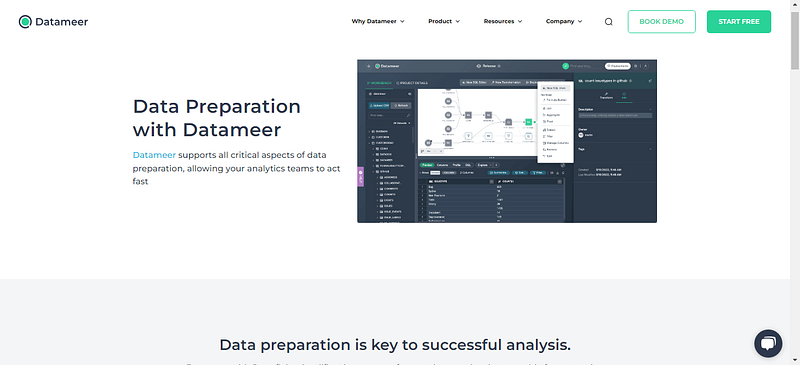Open-Source Data Tools are Hard; Here’s Why You Should Switch to Datameer
- Ndz Anthony
- June 30, 2023

Once upon a time, open-source data tools were seen as the new frontiers for businesses wanting to lower their data analytics cost. They held the promise of flexibility and freedom, offering a world of limitless possibilities to those willing to delve into their depths.
With the global open-source service market projected to reach 50 billion dollars by 2026, businesses saw investing time and resources in mastering the intricacies of open-source tools as the key to unlocking the secrets hidden within their code.
However, as the data landscape evolved and businesses faced mounting challenges, they discovered that the path they had chosen could have been smoother.
The truth is that open-source data tools have failed. This has become glaring as the initial allure of open-source wanes, with businesses encountering several roadblocks threatening their success.
Here are clear reasons why open-source data tools have failed to live up to expectations.
Problems of open-source data tools.

Open-source data tools are riddled with many challenges, which is why any smart business will take the extra step to go beyond them.
Here are some of the problems plaguing open-source data tools.
1.Open-source data tools are not user-friendly, they’re difficult to use.
This is a big problem for organizations looking to use them. They have to spend a lot of money and resources training their workers to use these tools.
To make matters worse, the tools’ lack of user-friendly interface and features affect productivity and slows down adoption. In fact in the long run, instead of lowering cost like they’re supposed to, they actually drive it up.
2. Open-source data tools are time-consuming and often lack the ability to perform advanced analytics.
Because open-source data tools are often very complex and lack vendor support, it takes a lot of time to get the different people that will be using it across the organization up to speed.
The truth is, not everyone will ever be able to get up to speed with it, there are just different people with different levels of tech knowledge. We just can’t expect a guy in marketing to be as fast as another in the data analysis team in knowing how to use these tools.
What is more? These tools are also handicapped when it comes to performing advanced analytics. You need a tool that can comfortably perform these types of analytics and even scale to accommodate any future growth in data needs, and open-source tools aren’t just cut out for this.
3. It is often very difficult to integrate open-source tools with existing systems.
This is a real problem for organizations especially now that businesses need to collaborate in real-time to share data and insights.
Sadly, open-source data tools are not the best when it comes to integrating data from multiple systems. They are famous for creating data siloes, with users also constantly grappling with compatibility issues.
4. Open-source tools face the problem of security and governance.
To maintain data integrity, there are various laws governing how data especially sensitive business data, is handled. It is very important that businesses handle data in compliance with regulatory laws and security measures to safeguard valuable data assets.
For open-source data tools, security is just another buzzword, after all, they’re not incentivized to make security a priority. Clearly, if your business handles sensitive data that needs to meet regulatory compliance laws then open-source is clearly not for you.
To overcome the myriads of limitations of open-source data tools, smart data-centric businesses now look to Datameer. Datameer is a leading data analytics platform.
Let’s explore the strengths of Datameer, (I like to call it; “the Datameer edge”) over open-source data tools, unraveling the reasons why your business cannot be left behind.
Why Datameer?
1. Intuitive User Interface:
One of the major advantages of Datameer is its intuitive user interface (UI), which simplifies complex data workflows.
Unlike open-source tools that require substantial coding expertise, Datameer’s visual interface allows users of all skill levels to easily navigate and work with data.
With a drag-and-drop approach, users can effortlessly build data pipelines, perform transformations, and create sophisticated analytics workflows without the need for extensive programming knowledge.
2. Time-Saving Data Preparation:

Data preparation is a crucial step in any data analysis project, but it can be time-consuming and resource-intensive with open-source tools.
Datameer streamlines this process by offering a wide range of built-in data preparation functions and connectors to various data sources.
Datameer offers automated data profiling, cleansing, and enrichment capabilities, empowering users to quickly prepare data for analysis, and enabling them to focus on generating insights instead of getting bogged down by tedious data cleaning tasks.
3. Advanced Analytics and Machine Learning:

While open-source tools provide a foundation for data analysis, they often lack advanced analytics and machine learning capabilities out of the box.
Datameer bridges this gap by offering a comprehensive advanced analytics and machine learning tools suite.
4. Enterprise-Grade Security and Governance:

When dealing with sensitive data, security, and governance become paramount. Open source tools may not provide the level of control and security measures required to ensure compliance and protect valuable data assets.
Datameer, on the other hand, offers enterprise-grade security features such as fine-grained access controls, data encryption, and auditing capabilities.
It enables organizations to adhere to strict regulatory requirements and maintain data integrity while providing a secure environment for collaboration.
5. Extensive Data Source and Ecosystem Integration:
Data is often scattered across multiple sources and systems, and open-source tools may require significant effort to integrate with various data platforms.
Datameer eliminates this complexity by offering seamless integration with various data sources and ecosystems.
Whether it’s Hadoop, cloud-based platforms like Snowflake, relational databases, or streaming data sources, Datameer’s extensive connectivity options ensure that data can be easily accessed, transformed, and analyzed regardless of its origin.
Conclusion:
Any business still depending on open-source data tools is clearly in a disadvantaged position with the inherent challenges that hinder productivity and limit the scope of data-driven initiatives.
Datameer on the other hand with its intuitive user interface, time-saving data preparation capabilities, advanced analytics tools, enterprise-grade security, and extensive integration options, provides a compelling alternative.
Switch to Datameer, and take your data to new heights.
Looking to unlock the full potential of your data? Get started with Datameer.


